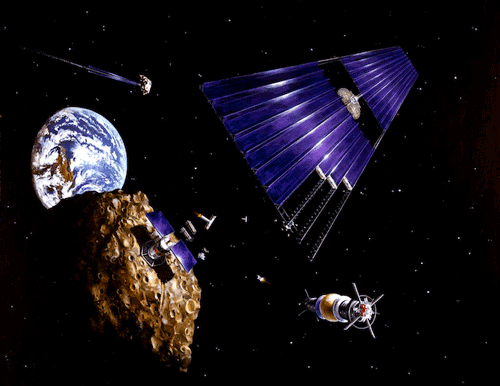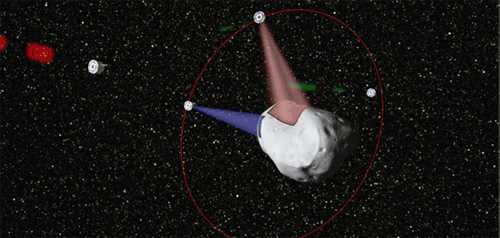Company announces plans to mine asteroids for resources
Celebrity investors back high-risk, high-reward project
Planetary Resources, Inc., a group made up of tech billionaires and former NASA scientists, formally announced their intention yesterday to mine Near-Earth Asteroids (NEAs) for materials ranging from water to precious metals.

Artist rendition of a robotic mining mission on a Near-Earth Asteroid. (Via: NASA/Denise Watt)
Eric Anderson and Peter H. Diamandis, M.D., who founded Planetary Resources back in 2009 and have stayed fairly mum about the project until yesterday, believe that resources extracted from asteroids will deliver many benefits to all of us here on Earth, and that the industry will eventually grow to be valued at tens of billions of dollars annually.
A little background
Outside the folks at NASA, Anderson and Diamandis are probably the most likely duo to pull off a project of this magnitude. Anderson founded the commercial space tourism company Space Adventures , while Diamandis started the X Prize foundation, which offers prize-based incentives for advanced technology development. Since both companies’ humble beginnings, Space Adventures has sent seven private tourists to the International Space Station, while the Ansari X Prize has led to a spurt of non-government-aided / manned spaceships, including the initial prize, won in 2004 by a team led by aerospace engineer Burt Rutan, whose SpaceShipOne flew 62 miles over the California desert.
Planetary Resources, already employs 25 engineers and has development contracts in place for technologies like laser communications, which will be used for prospecting and mining missions. The company also has an all-star list of investors and advisers, all of whom are listed a little further down.
An out of the world idea
Not that it’ll ever show up on a DMV test, but landing a spacecraft on an asteroid is not that difficult. They’re devoid of air and don’t have much gravitational pull to them, so it would actually take less fuel to land them on an asteroid then on, say, the moon or mars. As a matter of fact, a robotic mining spacecraft wouldn’t even need parachutes or a terribly large engine in order to fly up and attach itself to one.
Initial prospecting missions will target resource-rich, easily accessible asteroids for precious metals and water. Specifically regarding the former, the company hopes to target platinum-group metals (platinum, palladium, osmium, and iridium). That’s because, beyond jewelry, platinum is used in many of today’s electronic components, ranging from medical technologies to automobile catalytic converters. The problem is that right now the material costs close to $1,500 an ounce. For reference, if discovered and drilled, a 500-meter, platinum-rich asteroid would provide the equivalent of all the Platinum Group Metals mined in history.
“Many of the scarce metals and minerals on Earth are in near-infinite quantities in space,” explains Diamandis. “As access to these materials increases, not only will the cost of everything from microelectronics to energy storage be reduced, but new applications for these abundant elements will result in important and novel applications.”
In addition to digging for metals, the company plans to also target water-rich NEAs. This should be easy pickings, they figure, since a majority of these rocks are icy – with some being up to 20% water. The company’s thinking here is that these asteroids could one day serve, more or less, as “stepping stones” for deep space exploration, wherein the water can be broken down into liquid oxygen and hydrogen for rocket fuel, and oxygen for breathing.
“Water is perhaps the most valuable resource in space,” said Anderson. “Accessing a water-rich asteroid will greatly enable the large-scale exploration of the solar system. In addition to supporting life, water will also be separated into oxygen and hydrogen for breathable air and rocket propellant.”
How far will we have to travel to get to these asteroids?
The short answer is “not very far at all.” Of the nearly 9,000 NEAs that we know about, there are close to 1,500 that are as easy to reach as the Moon.
Planetary Resources has already developed the first line in its family of deep-space prospecting spacecraft; it’s called the “Arkyd-100 Series.” The bot is, essentially, a flying telescope that will be used in low-Earth orbit to scout the first round of NEA targets that have the right mix of minerals. They hope to launch between two and five space-based telescopes within the next year-and-a-half to two years to begin identifying potentially valuable asteroids.

A mock-up of the Arkyd-100 Space Telescope. (Via: Planetary Resources, Inc.)
Within five to seven years, the company hopes to send out a small swarm of similar spacecraft called the “Arky-300 Series”. These bots will target the resource-rich rock and provide the team with a more detailed prospecting mission; that is, they will map out the asteroids in detail and identify rich resource veins.

A mock-up of the Arkyd-300 Space Telescope. (Via: Planetary Resources, Inc.)
Actual mining would begin after that.
Chris Lewicki, President and Chief Engineer of Planetary Resources, who also previously worked as a manager on Mars missions at NASA’s Jet Propulsion Laboratory, said “Our mission is not only to expand the world’s resource base, but we want to increase people’s access to, and understanding of, our planet and solar system by developing capable and cost-efficient systems.”
Lewicki, along with Chris Voorhees, Vice President, Spacecraft Development, together make up the leadership team at Planetary Resources.
This project is not without its hurdles
There’s no doubt that the challenges facing this project are immense. After all, the only asteroid material ever returned to Earth came from the Japanese Space Agency’s Hayabusa spacecraft in 2010: it returned with a few hundred dust particles from asteroid 25143 Itokawa.
One problem is finding a resource-rich asteroid close enough to mine. A way in which experts theorize Planetary Resources might be able to find a useful asteroid would be to push the rock closer to Earth using a low-power, solar-electric ion engine.

Manned exploration of an asteroid pushed into lunar orbit, from a recent KISS white paper. (Via: NASA/AMA, Inc.)
Doing this would basically create a small second moon, and put the rock in position for it to be more easily accessed by the company.
Another option would be to bring the asteroid’s ore back to Earth for refining. This, however, presents its own set of challenges: how much weight can the bot carry, how to get the material safely through the Earth’s atmosphere, how to land the bot so that the material is not damaged, etc.
These hurdles could make the project more costly to run than the price of the material it will gather, so the company’s engineers and scientists will have to be innovative in their approach of making the mining process as efficient as possible.
A who’s who list of supporters
There are a ton of well-known figures from the tech community who have invested in Planetary Resources already, including Google CEO Larry Page, as well as Ross Perot, Jr., Chairman of Hillwood and The Perot Group. Both men have stated publicly that they are fully committed to expanding the world’s resource base so that we as a species can continue to grow and prosper here on our planet.
Also counted among Planetary Resource investors are Eric E. Schmidt, Ph.D., Executive Chairman of Google, Inc.; K. Ram Shriram, Founder of Sherpalo, Google Board of Directors founding member; and Charles Simonyi, Ph.D., Chairman of Intentional Software Corporation, who summed up his feelings of the project, saying, “The commercialization of space began with communications satellites and is developing for human spaceflight. The next logical step is to begin the innovative development of resources from space. I’m proud to be part of this effort.”
Counted among the company’s list of advisors is film maker and recent Marianna Trench conqueror, James Cameron; General T. Michael Moseley (retired); Sara Seager, Ph.D.; Mark Sykes, Ph.D.; Thomas Jones, Ph.D., veteran NASA astronaut, planetary scientist; John K. Villa, Partner, William & Connolly, LLP; and David Vaskevitch, a member of the senior management team of GETCO who previously served as Senior Vice President and Chief Technical Officer of Microsoft Corporation.
Outlook
The hope is that Planetary Resources will establish a new paradigm for resource utilization, and that this sort of outside-our-planet thinking will bring about new and exciting means for supporting life here on Earth.
To learn more, visit the Planetary Resources, Inc. website. ■
Advertisement
Learn more about Electronic Products Magazine





